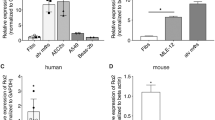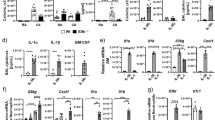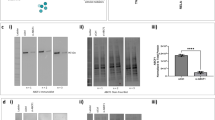Abstract
Interleukin 17 (IL-17) is critical in the pathogenesis of inflammatory and autoimmune diseases. Here we report that Act1, the key adaptor for the IL-17 receptor (IL-7R), formed a complex with the inducible kinase IKKi after stimulation with IL-17. Through the use of IKKi-deficient mice, we found that IKKi was required for IL-17-induced expression of genes encoding inflammatory molecules in primary airway epithelial cells, neutrophilia and pulmonary inflammation. IKKi deficiency abolished IL-17-induced formation of the complex of Act1 and the adaptors TRAF2 and TRAF5, activation of mitogen-activated protein kinases (MAPKs) and mRNA stability, whereas the Act1–TRAF6–transcription factor NF-κB axis was retained. IKKi was required for IL-17-induced phosphorylation of Act1 on Ser311, adjacent to a putative TRAF-binding motif. Substitution of the serine at position 311 with alanine impaired the IL-17-mediated Act1-TRAF2-TRAF5 interaction and gene expression. Thus, IKKi is a kinase newly identified as modulating IL-17 signaling through its effect on Act1 phosphorylation and consequent function.
This is a preview of subscription content, access via your institution
Access options
Subscribe to this journal
Receive 12 print issues and online access
$209.00 per year
only $17.42 per issue
Buy this article
- Purchase on Springer Link
- Instant access to full article PDF
Prices may be subject to local taxes which are calculated during checkout







Similar content being viewed by others
Change history
22 August 2011
In the version of this article initially published, the author Mark R. Chance was incorrectly identified as Mark Chance. The error has been corrected in the HTML and PDF versions of the article.
References
Bettelli, E. et al. Reciprocal developmental pathways for the generation of pathogenic effector TH17 and regulatory T cells. Nature 441, 235–238 (2006).
Cho, J.S. et al. IL-17 is essential for host defense against cutaneous Staphylococcus aureus infection in mice. J. Clin. Invest. 120, 1762–1773 (2010).
Conti, H.R. et al. Th17 cells and IL-17 receptor signaling are essential for mucosal host defense against oral candidiasis. J. Exp. Med. 206, 299–311 (2009).
Harrington, L.E. et al. Interleukin 17-producing CD4+ effector T cells develop via a lineage distinct from the T helper type 1 and 2 lineages. Nat. Immunol. 6, 1123–1132 (2005).
Iwakura, Y. & Ishigame, H. The IL-23/IL-17 axis in inflammation. J. Clin. Invest. 116, 1218–1222 (2006).
Kolls, J.K. & Linden, A. Interleukin-17 family members and inflammation. Immunity 21, 467–476 (2004).
Langrish, C.L. et al. IL-23 drives a pathogenic T cell population that induces autoimmune inflammation. J. Exp. Med. 201, 233–240 (2005).
Park, H. et al. A distinct lineage of CD4 T cells regulates tissue inflammation by producing interleukin 17. Nat. Immunol. 6, 1133–1141 (2005).
Alcorn, J.F., Crowe, C.R. & Kolls, J.K. TH17 cells in asthma and COPD. Annu. Rev. Physiol. 72, 495–516 (2010).
Kolls, J.K. & Khader, S.A. The role of Th17 cytokines in primary mucosal immunity. Cytokine Growth Factor Rev. 21, 443–448 (2010).
Kolls, J.K. Th17 cells in mucosal immunity and tissue inflammation. Semin. Immunopathol. 32, 1–2 (2010).
Nakae, S. et al. Antigen-specific T cell sensitization is impaired in IL-17-deficient mice, causing suppression of allergic cellular and humoral responses. Immunity 17, 375–387 (2002).
Chang, S.H., Park, H. & Dong, C. Act1 adaptor protein is an immediate and essential signaling component of interleukin-17 receptor. J. Biol. Chem. 281, 35603–35607 (2006).
Hartupee, J., Liu, C., Novotny, M., Li, X. & Hamilton, T. IL-17 enhances chemokine gene expression through mRNA stabilization. J. Immunol. 179, 4135–4141 (2007).
Ho, A.W. & Gaffen, S.L. IL-17RC: a partner in IL-17 signaling and beyond. Semin. Immunopathol. 32, 33–42 (2010).
Huang, F. et al. Requirement for both JAK-mediated PI3K signaling and ACT1/TRAF6/TAK1-dependent NF-κB activation by IL-17A in enhancing cytokine expression in human airway epithelial cells. J. Immunol. 179, 6504–6513 (2007).
Kao, C.Y. et al. Up-regulation of CC chemokine ligand 20 expression in human airway epithelium by IL-17 through a JAK-independent but MEK/NF-kappaB-dependent signaling pathway. J. Immunol. 175, 6676–6685 (2005).
Qian, Y. et al. The adaptor Act1 is required for interleukin 17-dependent signaling associated with autoimmune and inflammatory disease. Nat. Immunol. 8, 247–256 (2007).
Shen, F. et al. IL-17 receptor signaling inhibits C/EBPβ by sequential phosphorylation of the regulatory 2 domain. Sci. Signal. 2, ra8 (2009).
Shen, F. & Gaffen, S.L. Structure-function relationships in the IL-17 receptor: implications for signal transduction and therapy. Cytokine 41, 92–104 (2008).
Toy, D. et al. Cutting edge: interleukin 17 signals through a heteromeric receptor complex. J. Immunol. 177, 36–39 (2006).
Novatchkova, M., Leibbrandt, A., Werzowa, J., Neubuser, A. & Eisenhaber, F. The STIR-domain superfamily in signal transduction, development and immunity. Trends Biochem. Sci. 28, 226–229 (2003).
Swaidani, S. et al. The critical role of epithelial-derived Act1 in IL-17- and IL-25-mediated pulmonary inflammation. J. Immunol. 182, 1631–1640 (2009).
Li, X. et al. Act1, an NF-κB-activating protein. Proc. Natl. Acad. Sci. USA 97, 10489–10493 (2000).
Schwandner, R., Yamaguchi, K. & Cao, Z. Requirement of tumor necrosis factor receptor-associated factor (TRAF)6 in interleukin 17 signal transduction. J. Exp. Med. 191, 1233–1240 (2000).
Liu, C. et al. Act1, a U-box E3 ubiquitin ligase for IL-17 signaling. Sci. Signal. 2, ra63 (2009).
Peters, R.T., Liao, S.M. & Maniatis, T. IKKepsilon is part of a novel PMA-inducible IκB kinase complex. Mol. Cell 5, 513–522 (2000).
Shimada, T. et al. IKK-i, a novel lipopolysaccharide-inducible kinase that is related to IkappaB kinases. Int. Immunol. 11, 1357–1362 (1999).
Fitzgerald, K.A. et al. IKKɛ and TBK1 are essential components of the IRF3 signaling pathway. Nat. Immunol. 4, 491–496 (2003).
Hemmi, H. et al. The roles of two IκB kinase-related kinases in lipopolysaccharide and double stranded RNA signaling and viral infection. J. Exp. Med. 199, 1641–1650 (2004).
Kawai, T. et al. IPS-1, an adaptor triggering RIG-I- and Mda5-mediated type I interferon induction. Nat. Immunol. 6, 981–988 (2005).
Sharma, S. et al. Triggering the interferon antiviral response through an IKK-related pathway. Science 300, 1148–1151 (2003).
Tebo, J.M. et al. Interleukin-1-mediated stabilization of mouse KC mRNA depends on sequences in both 5′- and 3′-untranslated regions. J. Biol. Chem. 275, 12987–12993 (2000).
Park, Y.C., Burkitt, V., Villa, A.R., Tong, L. & Wu, H. Structural basis for self-association and receptor recognition of human TRAF2. Nature 398, 533–538 (1999).
Ye, H., Park, Y.C., Kreishman, M., Kieff, E. & Wu, H. The structural basis for the recognition of diverse receptor sequences by TRAF2. Mol. Cell 4, 321–330 (1999).
Ye, H. et al. Distinct molecular mechanism for initiating TRAF6 signalling. Nature 418, 443–447 (2002).
Datta, S. et al. IL-17 regulates CXCL1 mRNA stability via an AUUUA/tristetraprolin-independent sequence. J. Immunol. 184, 1484–1491 (2010).
Hartupee, J., Li, X. & Hamilton, T. Interleukin 1alpha-induced NFκB activation and chemokine mRNA stabilization diverge at IRAK1. J. Biol. Chem. 283, 15689–15693 (2008).
Sun, D. et al. Treatment with IL-17 prolongs the half-life of chemokine CXCL1 mRNA via the TRAF5 and the splicing regulatory factor SF2/ASF. Nat. Immunol. advance online publication, doi:10.1038/ni.2081 (7 Aug 2011).
Fukunaga, R. & Hunter, T. MNK1, a new MAP kinase-activated protein kinase, isolated by a novel expression screening method for identifying protein kinase substrates. EMBO J. 16, 1921–1933 (1997).
Hitti, E. et al. Mitogen-activated protein kinase-activated protein kinase 2 regulates tumor necrosis factor mRNA stability and translation mainly by altering tristetraprolin expression, stability, and binding to adenine/uridine-rich element. Mol. Cell. Biol. 26, 2399–2407 (2006).
Rowlett, R.M. et al. MNK kinases regulate multiple TLR pathways and innate proinflammatory cytokines in macrophages. Am. J. Physiol. Gastrointest. Liver Physiol. 294, G452–G459 (2008).
Ueda, T., Watanabe-Fukunaga, R., Fukuyama, H., Nagata, S. & Fukunaga, R. Mnk2 and Mnk1 are essential for constitutive and inducible phosphorylation of eukaryotic initiation factor 4E but not for cell growth or development. Mol. Cell. Biol. 24, 6539–6549 (2004).
Sønder, S.U. et al. IL-17-induced NF-κB activation via CIKS/Act1: physiologic significance and signaling mechanisms. J. Biol. Chem. 286, 12881–12890 (2011).
Lauer, M.E. et al. Differentiated murine airway epithelial cells synthesize a leukocyte-adhesive hyaluronan matrix in response to endoplasmic reticulum stress. J. Biol. Chem. 283, 26283–26296 (2008).
Schwieters, C.D., Kuszewski, J.J., Tjandra, N. & Clore, G.M. The Xplor-NIH NMR molecular structure determination package. J. Magn. Reson. 160, 65–73 (2003).
Kiefer, F., Arnold, K., Kunzli, M., Bordoli, L. & Schwede, T. The SWISS-MODEL Repository and associated resources. Nucleic Acids Res. 37, D387–D392 (2009).
Kopp, J. & Schwede, T. The SWISS-MODEL Repository of annotated three-dimensional protein structure homology models. Nucleic Acids Res. 32, D230–D234 (2004).
Clore, G.M. & Schwieters, C.D. Docking of protein-protein complexes on the basis of highly ambiguous intermolecular distance restraints derived from 1H/15N chemical shift mapping and backbone 15N–1H residual dipolar couplings using conjoined rigid body/torsion angle dynamics. J. Am. Chem. Soc. 125, 2902–2912 (2003).
Clore, G.M. & Kuszewski J. Chi1 rotamer populations and angles of mobile surface side chains are accurately predicted by a torsion angle database potential of mean force. J. Am. Chem. Soc. 124, 2866–2867 (2002)
Acknowledgements
We thank T. Maniatis (Harvard University) for IKKi-deficient and wild-type C57BL/6 control mice; and the High Performance Computing Resource in the Core Facility for Advanced Research Computing and Center of Proteomics and Bioinformatics at Case Western Reserve University. Supported by the American Asthma Foundation (X.L.), the US National Institutes of Health (R01HL098935-01A1 to X.L.) and the American Heart Association (09POST2010041 to R.C.P.).
Author information
Authors and Affiliations
Contributions
K.B., C.L., S.S., L.W., M.F.G., T.H., W.Q. and D.S., experiments; K.B. and C.L., experimental design, performance and interpretation and writing of the manuscript; L.W. and M.R.C., mass spectrometry study; R.C.P. and S.M., structure modeling; A.A., M.L. and V.H., assistance with the primary mouse airway epithelial cell culture; M.A., assistance with in vivo experiments; X.L. and T.H., design and interpretation of experiments and writing of the manuscript; all authors, review of the final manuscript.
Corresponding author
Ethics declarations
Competing interests
The authors declare no competing financial interests.
Rights and permissions
About this article
Cite this article
Bulek, K., Liu, C., Swaidani, S. et al. The inducible kinase IKKi is required for IL-17-dependent signaling associated with neutrophilia and pulmonary inflammation. Nat Immunol 12, 844–852 (2011). https://doi.org/10.1038/ni.2080
Received:
Accepted:
Published:
Issue Date:
DOI: https://doi.org/10.1038/ni.2080
This article is cited by
-
New insights into the function of Interleukin-25 in disease pathogenesis
Biomarker Research (2023)
-
FXYD3 enhances IL-17A signaling to promote psoriasis by competitively binding TRAF3 in keratinocytes
Cellular & Molecular Immunology (2023)
-
The IL-17 family in diseases: from bench to bedside
Signal Transduction and Targeted Therapy (2023)
-
Targeted Therapy of Spinal Cord Injury: Inhibition of Apoptosis Is a Promising Therapeutic Strategy
Molecular Neurobiology (2023)
-
The NF-κB Pathway: a Focus on Inflammatory Responses in Spinal Cord Injury
Molecular Neurobiology (2023)



